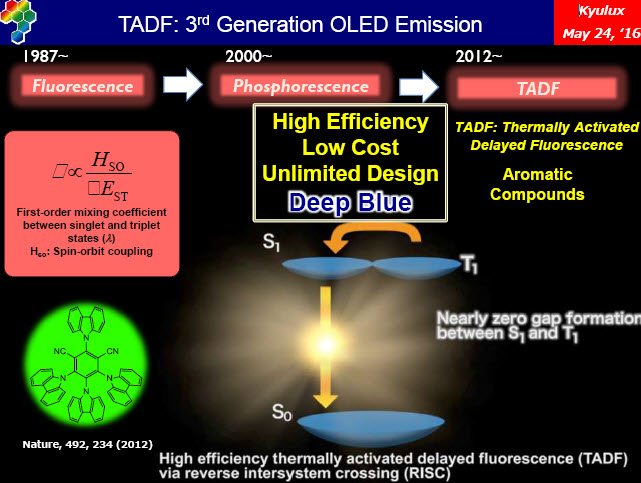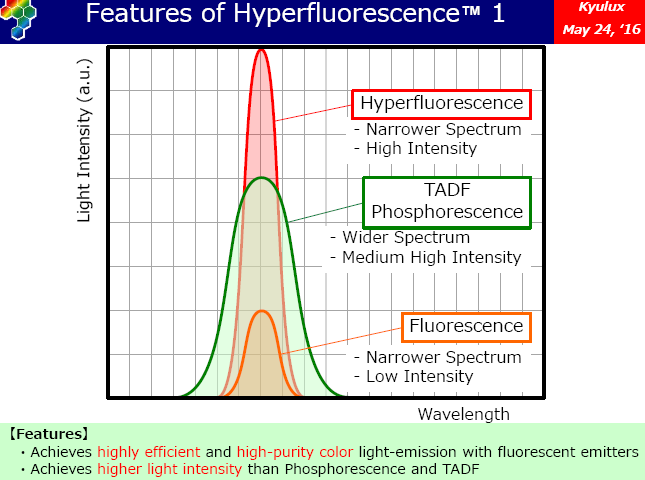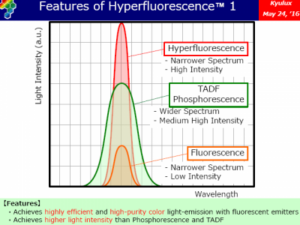Christopher Savoie is from Kyulux, in Kyushu, Japan, where he is CEO. The company was founded a year ago, and has funding from a range of VCs as well as Samsung Display, LG Display, JDI and JOLED. However, the project was started a long time ago to build a cluster in Fukuoka for R&D in OLEDs. The company is doing everything from basic science to device fabrication.
Kyulux has a technical team from Sony, Samsung, Sharp and Fuji Film and others and includes staff from Korea, Hong Kong, Taiwan, the US and Canada as well as Japan. Savoie is proud of the diversity of his team in nationality and gender.
The final presentation in the business conference session on the previous day was from Junji Adachi who is CTO of Kyulux. He described the firm’s material as having “hyperfluorescent” technology, the ‘fourth generation of OLED’.
He started by talking about the much better dynamic range of OLEDs compared to LCD, because of the better black level. Material is the critical factor for OLEDs, in his view. The first generation of OLED materials was low cost, using fluorescence, but only has a maximum efficiency of 25%. The second generation was phosphoresence to get to 100% efficiency but was not able to offer a deep blue. Third generation materials are TADF where the triplet emission is converted to singlet and then up converted to light. TADF also allows deep blue. 100% efficiency is achieved in internal quantum efficiency. The material is fully organic, rather than metallorganic.

However, the light output of ‘normal’ TADF, Adachi said, is quite wide spectrum, which means that you can’t make saturated colours. Kyulux has solved this problem and calls its technology hyperfluorescence. The technology is based on fluorescent materials but gets a narrower and better spectrum – with 4X light output. Adachi said that the process is simple using evaporation. The TADF material is combined with host material to achieve this.

Savoie showed performance figures which showed that the firm has now got to 1600 hours at 1000 cd/m² for TADF green, and the company will announce lifetimes for blue in September. In hyperfluorescence, the company is achieving 10% EQE at 500cd/m² for blue.
Savoie said it has long life, high brightness and low cost. The company wants to work with other companies that make materials. The firm believes it can allow OLED makers to move back from ‘Pentile’ structures to RGB stripes. It is working with Kyushu University which has a cluster in Fukuoka, Japan.
In questions, Adachi said that Kyulux is currently working on evaporation to get to market as soon as possible, but the company is working with JOLED for the future development of soluble materials. Sorin of Cynora agreed that it is working on soluble materials as well as evaporation, but evaporation is likely to come to market first. (BR)
Analyst Comment
We heard that Savoie is a respected lawyer and his Linked In page lists him as the Inventor of the Natural Language Understanding (NLU) technology behind Apple’s Siri, which gives him a lot of technology kudos. Getting Japanese and Korean investors also seems a good move and makes me wonder if the plan is to limit the availability of Kyulux material to Chinese companies. Certainly, a high tech company run by an American in Japan and with Korean majors among its investors is an unusual situation. However, Kyulux must be onto something. (BR)

